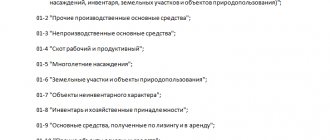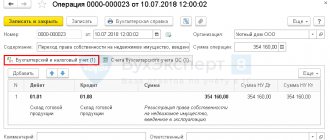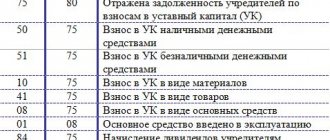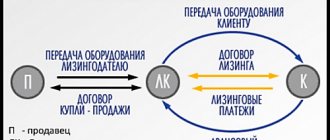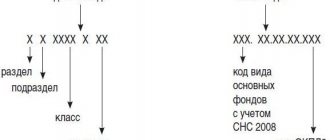In this article we begin a new and important topic: fixed assets. Let's understand the definition of fixed assets, find out how accounting is kept when receiving fixed assets, what transactions are made and on the basis of what primary documents.
Accounting for fixed assets at an enterprise is regulated by the Accounting Regulations “Accounting for Fixed Assets” PBU 6/01.
I advise you to read the Regulations yourself, but I will explain in simpler language the main, in my opinion, aspects.
PBU 6/01 gives the following definition of fixed assets .
Fixed assets are tools with a useful life of more than 1 year, not intended for resale and capable of bringing economic benefit to the organization.
The useful life is understood as the time during which an object is capable of bringing economic benefits to the enterprise.
On the basis of what documents is the receipt of fixed assets regulated?
Regulatory documents that are used as the basis for reflecting fixed assets in accounting and tax accounting at an enterprise include:
- Law “On Accounting” No. 402 FZ - this act defines the principles of accounting and basic concepts.
- Tax Code of the Russian Federation - this act establishes the general concepts of OS and the procedure for accounting for such objects in tax accounting.
- Regulations on accounting and accounting in Russia No. 34 - this act defines the concept of OS, and also provides a classification of these objects.
- PBU 61 is a leading regulatory act that defines not only what fixed assets are, but also establishes the rules for their assessment, accounting, execution using documents, etc.
- Guidelines for maintaining fixed assets accounting No. 91 - this act establishes the main methods for recording fixed assets, and also discusses the features of individual operations for accounting for fixed assets.
- Chart of accounts and instructions for its use No. 94n - defines the accounts on which fixed assets are recorded, and also establishes standard correspondence of these accounts with other accounting accounts.
Attention! When reflecting the receipt of fixed assets, other regulations can be used, for example, PBU 9/99 and PBU 10/99 regarding the occurrence of income and expenses that arise when purchasing fixed assets, as well as guidelines for conducting an inventory.
Nuances of attracted financing
Funds raised are always targeted, require mandatory reporting to the authority that provided them and are divided into:
- irrevocable, which should include budget funds for special purposes;
- repayable, provided for a time by the budget or any trust fund;
- equity, forming that part of the investment in the value of the fixed assets that will belong to other legal entities or individuals.
Read more about targeted financing in the material “Art. 251 Tax Code of the Russian Federation (2015): questions and answers.”
Initial OS cost
An important characteristic of an asset is its initial cost. It is based on the amount the company costs to purchase this property. This cost is added up by summing up the direct costs of purchasing the OS, as well as the costs of its installation, delivery, registration, registration, etc.
It is formed on the basis of information from primary documentation received when purchasing an object. Sources of receipt of fixed assets influence the process of formation of the initial price of an object.
If the object is received under a purchase and sale agreement, then the main cost for the initial cost comes from the purchase price of the object and services for its delivery.
If a facility is created within an organization (for example, the construction of a building), the initial cost reflects the company's investment in creating the facility. When an operating system is created at the expense of one’s own resources, this is primarily the price of materials and payments for labor. When attracting contractors, a larger amount of the initial cost falls on the price of services under contract agreements.
OS can come to the organization in the form of a contribution from one of the owners of the company. Then the initial cost is assigned by a monetary valuation of the object agreed upon by the founders.
When an asset is received free of charge, its initial price is calculated as the current market value of similar property on the day of receipt.
It is possible that the company pays for fixed assets not in cash, but with some other material assets (for example, an exchange agreement), then the initial price of this type of property is equal to the value of the objects transferred for it.
Attention! The initial price of the fixed asset remains with him until the fact of his disposal.
Types of funding sources
Sources of financing of fixed assets are divided into:
- internal;
- external.
Internal (own) include:
- depreciation of fixed assets and intangible assets;
- capital (both capital and profit).
External sources are third party tools:
- borrowed (credits, loans);
- attracted.
During the financing process, sources of funds can be combined. The organization has the right to independently determine the share of participation of each of them in paying for fixed assets. It is more preferable to assess the financial position of a legal entity from the point of view of financial stability is the predominance of its own sources over external ones.
For more information about the analysis of financial stability and the coefficients calculated in this case, read the material “Conducting an analysis of the financial stability of an organization.”
Analytical and synthetic accounting of fixed assets
Accounting for fixed assets is carried out on the basis of the Chart of Accounts on the following synthetic accounts:
- Account 01 “Fixed Assets” – shows fixed asset objects broken down by their types at original cost. Analytical accounting is carried out according to the following types: buildings, structures, transmission devices, machinery and equipment, vehicles, inventory, and others. There is also an analytical account to reflect the write-off of fixed assets (01/9).
- Account 02 “Depreciation of fixed assets” – fixed assets are shown in the amount of accumulated depreciation (that is, part of the price of the object transferred to expenses). Analytical accounting is performed in the same way as for account 01
- Account 03 “Income-earning investments” - is used to account for fixed assets acquired to generate income by renting them out. Analytical accounting is performed either by type of operating system or by tenant.
- Account 07 “Equipment for installation” – takes into account OS objects for which installation needs to be carried out. Analytical accounting is carried out by type of object.
- Account 08 “Investments in non-current assets” - is used to accumulate the initial price of incoming objects. All costs associated with the purchase of the OS are accumulated here. Analytical accounting is performed by type of investment.
You might be interested in:
An employee took a taxi on a business trip - is it possible to deduct these expenses?
Using your own sources
The use of exclusively its own sources indicates the financial independence of the organization and allows it to:
- promptly resolve issues related to the acquisition (creation) of an OS;
- do not spend money on paying expenses that accompany the use of credits (loans).
Of these, the most important:
- depreciation, which allows you to gradually transfer the cost of operating operating systems to expenses, thereby giving the legal entity the opportunity to obtain additional working capital for the ongoing replacement of worn-out assets (simple reproduction) or bringing them to modern requirements through modernization (reconstruction);
- net profit, at the expense of which expensive acquisitions are made and equipment for new types of activities is purchased (expanded reproduction).
Methods of obtaining OS
The source of an OS object coming into an organization may be different. In any case, its initial price will be accumulated on account 08, and then transferred to account 01.
Purchasing from a supplier
This method of receiving OS is the most common. In this case, the initial price will be the amount the company costs to purchase this object, excluding tax payments.
The arrival of the OS is formalized with standard documents:
- OS-1 - upon arrival of the OS, with the exception of the building or structure;
- OS-1a - upon receipt of a building or structure;
- OS-1b - when a group of funds arrives at once, excluding buildings and structures;
- OS-6 - inventory card at the time of drawing up the OS-1 act.
The purchase and entry of an OS object is carried out using the following transactions:
| Debit | Credit | Operation |
| The purchased OS has been registered | ||
| 19 | 60 | Input VAT on the acquisition transaction has been registered |
| 08 | 60, 76 | Additional costs for delivery, commissioning, etc. have been taken into account. |
| 68 | 19 | VAT credited |
| 08 | The OS object has been put into operation |
OS construction
A company can receive fixed assets as a result of capital construction. In such a situation, its initial price will be based on all expenses incurred for materials, their transportation to the work site, as well as the cost of contract work.
At the time of receiving the building, this must be documented:
- Act KS-11 or KS-14 - at the time of acceptance of the completed object from the contractor;
- OS-1a - upon receipt of a building or structure;
- OS-6 - inventory card at the time of drawing up the OS-1a act.
The object must be registered immediately after the execution of the mentioned documents. Completion of the procedure for state registration of property rights does not affect the day of registration.
During construction and commissioning, the following wiring is drawn up:
| Debit | Credit | Operation |
| 08 | 60, | Recorded cost of contract work |
| 08 | Materials issued for the construction of the facility have been accepted for registration | |
| 08 | 60, 76, 23, 25, 26 | Other costs for the construction of the operating system were taken into account |
| 19 | 60, 76, 23, 25, 26 | Input VAT on construction-related work has been taken into account |
| 01 | 08 | The OS object has been accepted for operation |
| 68 | 19 | VAT credited |
OS as a contribution to the authorized capital
OS can come to the organization as a contribution from a company participant when creating the authorized capital. In the form of the initial price, you need to take the value that was established between the founders through negotiations. Moreover, such a price should not be higher than the result of an independent assessment carried out in accordance with the law when making a non-monetary share in the capital.
If the fixed assets are transferred as a contribution to capital from another company, and it is a VAT payer, then the input tax can be subsequently deducted.
The arrival of the OS is formalized with standard documents:
- OS-1 - upon arrival of the OS, with the exception of the building or structure;
- OS-1a - upon receipt of a building or structure;
- OS-1b - when a group of funds arrives at once, excluding buildings and structures;
- OS-6 - inventory card at the time of drawing up the OS-1 act.
The following entries are made in accounting:
| Debit | Credit | Operation |
| 08 | 75 | Income of OS as a contribution to the authorized capital |
| 08 | 23, 25, 26, 60, 76 | The costs of bringing the transferred OS to operational condition have been taken into account |
| 19 | 60, 76 | VAT on services provided to bring the OS to a suitable condition is taken into account |
| 19 | 83 | VAT is taken into account when transferring fixed assets as a contribution from another organization |
| 01 | 08 | OS accepted for use |
| 68 | 19 | VAT credited |
You might be interested in:
08 accounting account - “Investments in non-current assets”
Capitalization of unaccounted assets based on inventory results
In accordance with regulatory documents, the organization is obliged to conduct an annual inventory of OS. In addition, the start of this procedure can be initiated by an order from the head of the company.
The inventory must be carried out in the presence of a special commission. It includes representatives of the accounting department, materially responsible persons, and third parties who are not employees of the company.
The final results of the inventory are entered into a special statement using the standardized form INV-26.
Attention! If the results of the procedure revealed fixed assets that are not registered with the organization, then they must be capitalized in the same month. If the inventory is carried out before the approval of the annual statements, then its results are reflected in it.
For the purposes of calculating income tax, the price of surplus fixed assets is taken into account within non-operating income.
Registration based on the inventory sheet is carried out using standard forms:
- OS-1 - upon arrival of the OS, with the exception of the building or structure;
- OS-1a - upon receipt of a building or structure;
- OS-1b - when a group of funds arrives at once, excluding buildings and structures;
- OS-6 - inventory card at the time of drawing up the OS-1 act.
This is shown in accounting as follows:
| Debit | Credit | Operation |
| 08 | 91 | Registration of an asset discovered following an inventory |
| 01 | 08 | Acceptance for operation of an OS object |
Get the OS for free
When receiving fixed assets free of charge, the market price on the day of donation is used in the form of its original price. A peculiarity of such receipt of fixed assets will be the attribution of its price to income gradually, as the depreciation of the object is calculated.
The leading document on the basis of which the donation is made is the corresponding agreement. In addition, the transferring party draws up a primary document - an invoice or delivery note.
Based on them, the receiving party registers the OS object, making up:
- OS-1 - upon arrival of the OS, with the exception of the building or structure;
- OS-1a - upon receipt of a building or structure;
- OS-1b - when a group of funds arrives at once, excluding buildings and structures;
- OS-6 - inventory card at the time of drawing up the OS-1 act.
Accounting entries are prepared as follows:
| Debit | Credit | Operation |
| 08 | 98 | Receiving OS under a gift agreement |
| 01 | 08 | Registration as OS |
| , 23, 23, 25, 26, 44 | 02 | Monthly calculation of depreciation |
| 98 | 91 | Part of the cost of a fixed asset is accepted as other income (in the amount of accrued depreciation) |

